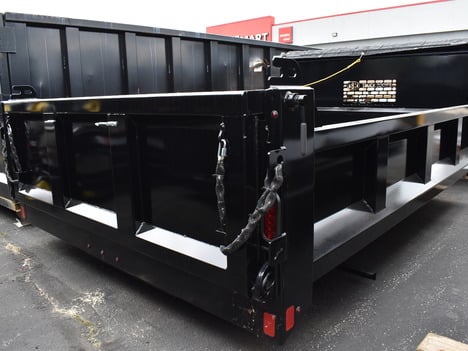Dump Bodies For Pickup Trucks: Transforming Your Hauler into a Workhorse pickup.truckstrend.com
Pickup trucks are the quintessential workhorses of the modern world, renowned for their versatility, power, and utility. From hauling tools and materials to towing trailers, they serve a multitude of purposes for tradespeople, landscapers, homeowners, and adventurers alike. However, even the most capable pickup has a limitation: the manual labor involved in unloading bulk materials. This is where dump bodies for pickup trucks come into play, revolutionizing the way you transport and offload everything from gravel and dirt to mulch and construction debris.
A dump body, in essence, transforms your standard pickup bed into a hydraulic dumping mechanism, allowing you to effortlessly unload loose materials with the push of a button. No more back-breaking shoveling, no more prolonged job site delays, just efficient, automated material discharge. For anyone who regularly deals with bulk loads, a pickup dump body isn’t just an accessory; it’s an indispensable upgrade that boosts productivity, saves time, and significantly reduces physical strain. This comprehensive guide will delve into every aspect of dump bodies for pickup trucks, helping you understand their benefits, types, considerations, and how to choose the perfect one for your needs.
Dump Bodies For Pickup Trucks: Transforming Your Hauler into a Workhorse
What Are Dump Bodies For Pickup Trucks and How Do They Work?
At its core, a dump body for a pickup truck is a specialized bed insert or a complete bed replacement designed to tilt and empty its contents. It typically consists of a durable steel or aluminum box, a robust subframe, and an electro-hydraulic lifting system.
The "magic" happens through this hydraulic system. A compact 12-volt electric motor powers a hydraulic pump, which in turn pushes hydraulic fluid into a cylinder. As the cylinder extends, it lifts the front of the dump body, causing the material to slide out the rear tailgate. Controls are usually wired to a handheld remote, allowing the operator to manage the dumping process safely and precisely. Some systems also include a power-down feature for controlled lowering of the bed, while others rely on gravity.
These units are engineered to handle significant weight, effectively turning your everyday pickup into a miniature dump truck, capable of tackling jobs that would otherwise require manual labor or a much larger, more expensive piece of equipment.
The Unrivaled Benefits of a Pickup Dump Body
Investing in a dump body for your pickup truck offers a wealth of advantages that translate directly into increased efficiency and profitability for professionals, and unparalleled convenience for homeowners:
- Massive Time Savings: The most obvious benefit. Instead of shoveling materials out of your truck bed for minutes or even hours, you can unload an entire load in a matter of seconds. This drastically reduces turnaround time at job sites or material yards.
- Reduced Physical Strain & Injury Risk: Manual unloading is incredibly taxing on the back, shoulders, and arms. A dump body eliminates this strenuous labor, significantly reducing the risk of fatigue and musculoskeletal injuries, keeping you and your crew healthier and more productive.
- Increased Productivity & Profitability: By saving time and reducing physical effort, you can complete more jobs in a day. For businesses, this directly translates to higher revenue and better utilization of resources.
- Versatility: Dump bodies are ideal for a wide range of materials, including:
- Dirt, sand, gravel, and stone
- Mulch, topsoil, and compost
- Firewood and logs
- Construction debris (concrete, asphalt, wood scraps)
- Landscaping materials

- Cost-Effectiveness: For many small businesses, contractors, or serious DIYers, purchasing a full-size dump truck is overkill and cost-prohibitive. A pickup dump body offers much of the functionality at a fraction of the cost, leveraging your existing vehicle.
- Enhanced Safety: Controlled dumping reduces the risk of material spillage during unloading, and the absence of manual labor in a potentially unstable environment improves overall job site safety.
- Preserves Your Truck Bed: The dump body often acts as a liner, protecting your original truck bed from scratches, dents, and corrosion caused by abrasive materials.


Types, Materials, and Key Considerations
Dump bodies for pickup trucks come in various configurations, each with its own advantages. Understanding these differences is crucial for making an informed decision.
1. Types of Dump Bodies:
- Insert Dump Bodies: These are the most common type for pickup trucks. They are designed to fit directly into your existing truck bed, utilizing its sidewalls and tailgate (though many come with their own integrated tailgate). They are generally easier to install and remove, making them a popular choice for those who want to retain the original truck bed’s functionality when not dumping.
- Flatbed Dump Bodies: These units replace the entire truck bed with a flat deck that can tilt to dump. While less common for standard pickups due to the extensive modification required, they offer maximum versatility for hauling oversized or palletized loads in addition to bulk materials.
2. Materials:
- Steel: The traditional choice, known for its exceptional durability and strength. Steel dump bodies can withstand heavy abuse and are often more affordable upfront. However, they are heavier, which reduces your truck’s effective payload capacity, and are susceptible to rust if not properly maintained.
- Aluminum: A lighter alternative, aluminum dump bodies offer superior corrosion resistance and can significantly increase your truck’s usable payload capacity (as the body itself weighs less). While more expensive initially, their longevity and reduced impact on payload can make them a wise investment over time.
3. Lift Mechanisms:
Most pickup dump bodies use a 12-volt electric over hydraulic system, powered directly by your truck’s battery. This is the most practical and common method, offering simplicity and reliability. Larger, commercial-grade dump bodies might use PTO (Power Take-Off) driven hydraulic pumps, but these are rarely found on pickup truck applications.
4. Critical Considerations Before Purchase:
- Truck Compatibility & Payload Capacity: This is paramount. Every pickup truck has a Gross Vehicle Weight Rating (GVWR) and a specific payload capacity (the maximum weight your truck can carry, including passengers, fuel, and cargo). You must ensure that the combined weight of the dump body itself, the materials you intend to haul, and any passengers/gear does not exceed your truck’s payload capacity. Overloading is dangerous and can void warranties or lead to costly damage.
- Bed Dimensions: Measure your truck bed’s length and width accurately to ensure the dump body insert or replacement will fit properly.
- Capacity (Volume & Weight): Dump bodies are rated by their cubic yard volume (e.g., 1.5 cubic yards) and their maximum lifting weight capacity. Match these to your typical hauling needs.
- Tailgate Style:
- Barn Door/Double Door: Opens like conventional doors, great for wide access or spreading materials.
- Spreader Gate: Features a small opening at the bottom, allowing for controlled spreading of materials like gravel or sand.
- Combination Gate: Offers both barn door and spreader gate functionality.
- Power Source: Ensure your truck’s electrical system can support the dump body’s power requirements. A heavy-duty battery and alternator might be beneficial for frequent use.
- Accessories: Consider options like tarp systems (essential for securing loose loads), side extensions for increased volume, and remote control upgrades.
Installation and Maintenance Tips
While some insert dump bodies are designed for DIY installation, professional installation is often recommended, especially for more complex units or if you’re unsure about electrical wiring and hydraulic systems.
Installation Overview (General Steps):
- Prepare the Truck Bed: Clear out the bed and ensure it’s clean.
- Position the Dump Body: Carefully lift and set the dump body into the truck bed.
- Secure Mounting: Bolt the dump body’s subframe securely to the truck’s frame or bed floor, following manufacturer instructions.
- Electrical Hookup: Connect the dump body’s electrical system to the truck’s battery, typically requiring a direct connection to ensure sufficient power. Fuse protection is critical.
- Hydraulic Fluid: Fill the hydraulic reservoir with the recommended fluid.
- Test: Cycle the dump body through its full range of motion, checking for proper operation and leaks.
Essential Maintenance for Longevity:
Regular maintenance is key to ensuring your dump body performs reliably for years.
- Hydraulic Fluid Check: Regularly inspect the hydraulic fluid level and top off as needed. Use only the manufacturer-recommended hydraulic fluid.
- Hose & Cylinder Inspection: Check hydraulic hoses for cracks, leaks, or chafing. Inspect the hydraulic cylinder for damage or leaks.
- Lubrication: Keep all pivot points, hinges, and moving parts well-lubricated with grease to prevent wear and ensure smooth operation.
- Electrical Connections: Periodically check all electrical connections for corrosion or looseness. Keep them clean and tight.
- Rust Prevention (Steel Bodies): For steel units, inspect for rust spots and address them promptly with touch-up paint or rust-inhibiting coatings.
- Frame Mounts: Ensure all mounting bolts connecting the dump body to the truck frame are tight and secure.
- Cleanliness: Keep the dump body clean, especially after hauling corrosive materials like salt or fertilizer.
Choosing the Right Dump Body: Practical Advice
- Assess Your Truck’s Capability: Before anything else, know your truck’s exact make, model, year, and most importantly, its payload capacity (found in your owner’s manual or on a sticker in the door jamb). This will dictate the maximum size and weight of the dump body and material you can safely carry.
- Define Your Needs: What will you primarily haul? How often? What volume? This will help you decide on material (steel vs. aluminum), capacity, and specific features like tailgate style. If you occasionally haul light mulch, a basic aluminum insert might suffice. If you’re moving heavy gravel daily, a robust steel unit is probably better.
- Consider Your Budget: Dump bodies vary widely in price based on material, size, features, and brand. Set a realistic budget and explore options within that range. Remember to factor in potential installation costs.
- Research Brands and Reviews: Look for reputable manufacturers known for quality and durability. Read customer reviews and seek recommendations from others in your industry.
- Professional Consultation: If you’re unsure, visit a local truck equipment dealer. They can provide expert advice, help with compatibility checks, and offer professional installation services.
Price Table: Estimated Dump Body Costs for Pickup Trucks
Please note: These prices are estimates and can vary significantly based on brand, features, material, specific truck model fit, and market conditions. Installation costs are typically separate.
| Dump Body Type | Material | Capacity (Cu. Yds. / Lbs.) | Estimated Price Range (USD) | Key Features & Notes |
|---|---|---|---|---|
| Light-Duty Insert | Steel | 0.75 – 1.5 / 3,000 – 5,000 | $2,500 – $4,500 | Basic functionality, ideal for occasional use, homeowners, or light landscaping. Fits inside existing truck bed. |
| Standard-Duty Insert | Steel | 1.5 – 2.0 / 5,000 – 7,000 | $4,000 – $6,500 | More robust, suitable for regular contractor use. Often includes integrated tailgate. |
| Standard-Duty Insert | Aluminum | 1.5 – 2.0 / 5,000 – 7,000 | $5,500 – $8,000 | Lighter weight, higher payload potential, corrosion-resistant. |
| Heavy-Duty Insert | Steel | 2.0 – 3.0 / 7,000 – 10,000 | $6,000 – $9,500 | Reinforced construction for demanding professional use. May require heavier-duty truck suspension. |
| Flatbed Dump Body | Steel | 2.0 – 4.0 / 8,000 – 12,000 | $8,000 – $15,000+ | Replaces entire truck bed. Offers flatbed utility plus dumping. Higher capacity but more complex installation. |
| Flatbed Dump Body | Aluminum | 2.0 – 4.0 / 8,000 – 12,000 | $10,000 – $18,000+ | Lightweight flatbed option, maximizing payload and corrosion resistance. Premium option. |
| Installation Services | N/A | N/A | $500 – $1,500+ | Varies based on complexity and shop rates. Highly recommended for safety and proper function. |
| Optional Accessories | N/A | N/A | $200 – $1,000+ | Tarp systems, side extensions, wireless remotes, ladder racks. |
Frequently Asked Questions (FAQ)
Q1: Can I install a dump body myself?
A1: Some lighter-duty insert dump bodies are designed for DIY installation if you have mechanical aptitude and basic electrical knowledge. However, for heavier units or if you’re uncomfortable with wiring and hydraulics, professional installation is highly recommended to ensure safety and proper operation.
Q2: Will a dump body damage my truck?
A2: When properly sized and installed according to the manufacturer’s guidelines, a dump body should not damage your truck. The key is to never exceed your truck’s Gross Vehicle Weight Rating (GVWR) and payload capacity. Overloading is the primary cause of potential damage to suspension, frame, and drivetrain.
Q3: What’s the difference between steel and aluminum dump bodies?
A3: Steel is heavier, more affordable, and extremely durable, but susceptible to rust. Aluminum is lighter (increasing your usable payload), corrosion-resistant, and typically more expensive upfront. Your choice depends on your budget, payload needs, and environmental conditions.
Q4: How much weight can a pickup dump body lift?
A4: Lift capacities vary significantly by model, ranging from 3,000 lbs for light-duty units to over 10,000 lbs for heavy-duty commercial models. Always check the manufacturer’s specifications and ensure it aligns with your truck’s payload capacity.
Q5: Do I need a special type of pickup truck for a dump body?
A5: While a dump body can be installed on most full-size pickup trucks (e.g., Ford F-150/250/350, Ram 1500/2500/3500, Chevy Silverado/GMC Sierra 1500/2500/3500), it’s crucial to match the dump body’s weight and capacity to your truck’s payload rating. Heavy-duty trucks (2500/3500 series) are generally better suited for larger, higher-capacity dump bodies.
Q6: How do I maintain the hydraulic system?
A6: Regular maintenance includes checking the hydraulic fluid level and quality, inspecting hoses and cylinders for leaks or damage, and lubricating all pivot points. Refer to your dump body’s owner’s manual for specific maintenance schedules and fluid types.
Q7: Are dump bodies for pickup trucks legal?
A7: Yes, dump bodies are legal as long as they are properly installed, the truck is not overloaded, and all road safety regulations (like securing loads with a tarp) are followed. Always check local regulations regarding vehicle modifications and weight limits.
Conclusion
Dump bodies for pickup trucks represent a significant leap forward in the utility and efficiency of your existing vehicle. By automating the arduous task of unloading bulk materials, they empower individuals and businesses to save time, reduce labor costs, minimize physical strain, and dramatically increase productivity. Whether you’re a landscaper moving mulch, a contractor hauling debris, or a homeowner tackling a major renovation, a well-chosen and properly maintained dump body transforms your pickup into an indispensable tool, proving that even a workhorse can be made to work smarter, not just harder. Investing in a dump body isn’t just buying an accessory; it’s investing in efficiency, safety, and the expanded capabilities of your trusted pickup truck.



